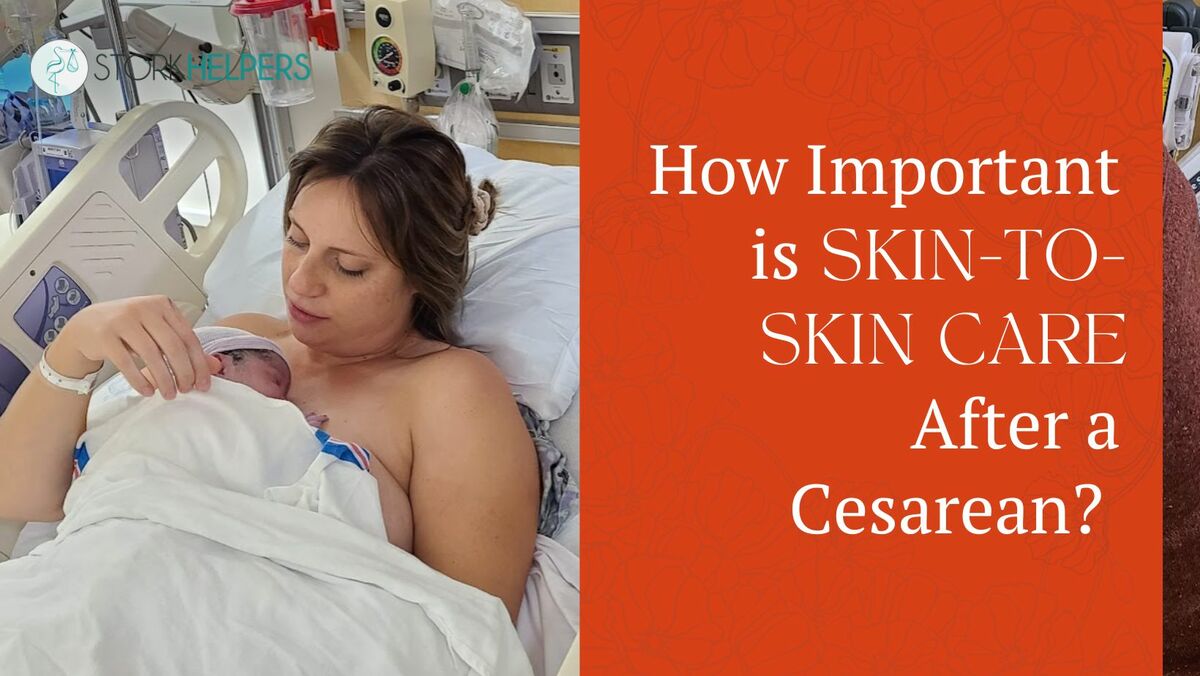How Important is Skin-to-Skin Care After a Cesarean?

The bond between mama and her baby is the strongest you will find anywhere on the planet.
Many natural instincts work together to create an instant attachment between a mama and her newborn. One of the ways this bond is made is through skin-to-skin care immediately after birth.
Early skin-to-skin care involves placing the naked newborn on the mama’s bare chest and covering the pair with blankets to keep them dry and warm.
Skin-to-skin care is a key step to infant bonding and should start immediately after, or shortly after, birth and last until the first breastfeeding session.
For those mamas who need cesarean sections during birth, skin-to-skin care is still important. However, many hospitals separate mama and baby after birth, especially if the baby was born via c-section.
What is a cesarean section, and what should I expect? Learn more here!
In this post, we will take a deeper look at skin-to-skin care, and how important skin-to-skin care is after a cesarean.
A Closer Look at Skin-to-Skin Care in Cincinnati and Dayton
If you are planning for a baby in Cincinnati or Dayton, then you must know the importance of skin-to-skin care.
Skin-to-skin contact is a key element in creating the parent-infant attachment that is so important, especially in the early months of life.
There are three main types of early skin-to-skin contact for healthy term infants.
- Immediate skin-to-skin contact starts within the first minute after birth
- Very early skin-to-skin care begins 30-40 minutes after birth
- Early skin-to-skin care is any skin-to-skin time that takes place during the first 24 hours of life
Skin-to-skin care is important for creating a strong parent-infant attachment and is very important for newborn development and maternal recovery.
Up until the 20th century, when births moved from the home to the hospital, skin-to-skin care was a given, as babies and mamas would be kept together for weeks after birth.
In the early 1900s, anesthesia became routine during birth, and babies were removed from their mothers 24-48 hours after birth.
It wasn’t until the 1960s that doctors discovered that anesthesia could be harmful to babies. The next few decades revealed the importance of skin-to-skin contact between mothers and babies.
Today, the CDC tracks skin-to-skin care in hospitals and birth centers in the US, and reported in 2015 that 83% of hospitals and birth centers practice routine skin-to-skin care for most mothers and babies for at least 30 minutes, less than one hour after an uncomplicated vaginal birth. This is a big jump from just 43% in 2009.
In the next section, we will look more closely at the importance of skin-to-skin care after a cesarean birth.
Skin-to-Skin Care After a Cesarean is Important
Many mamas have c-sections to ensure a healthy birth for their baby.
Around 32% of women in the US need cesarean sections. According to the CDC, only 70% of hospitals or birthing centers administered skin-to-skin care after a cesarean in 2015.
For many hospitals, the standard care routine after a c-section is to take the newborn to a warmer in the operating room, where they are then examined, cleaned, weighed, and labeled. Separation usually lasts between one and two hours.
Many mothers are experiencing a critical delay in bonding, skin-to-skin contact, and bonding because they are separated after birth.
Mothers who had skin-to-skin contact with their baby after birth were 24% more likely to still be breastfeeding one to four months after birth, as compared to those mothers and babies who were separated.
Further, babies held skin-to-skin after birth were 32% more likely to breastfeed on their first attempt.
To conclude, research has found that very early skin-to-skin contact after a cesarean is safe and beneficial. The low rate of skin-to-skin contact after cesareans may mean that mothers and families may face barriers to skin-to-skin contact after a cesarean.
Keeping mothers and babies together after a c-section is best practice and ultimately what is best for mama and her baby.
If you plan to give birth at a hospital or birthing center, be sure to know the hospital’s policy on separation and ensure that your preference for skin-to-skin contact is clear before the baby is born.
You may need a birth advocate like a doula or midwife present to ensure that your needs are met.
Stork Helpers is Your Cincinnati and Dayton Doula
Skin-to-skin care after birth – whether a c-section or vaginal birth – is important.
However, many hospitals and birthing centers still insist on separating mama and baby after birth.
To ensure that your needs are met and you and your baby have the necessary skin-to-skin contact, you need an advocate in your corner.
That is where the Stork Helpers team comes in. Our experienced doulas will speak up for you to ensure that you get skin-to-skin care after birth and that your postpartum and newborn recovery goes exactly as planned.
Maternal recovery and newborn development are important. Stork Helpers ensures that you get the postpartum care you need.
We help mamas and families in Cincinnati, Dayton, Warren county, Butler county, Miami county, Clermont county, and Hamilton county get the pregnancy, birth, and postpartum care they need.
If you are ready for a doula who always listens and never judges, book an appointment to meet Tamara and Skylar today!
If you are happy with the Stork Helpers difference, leave us a five-star review on Google here!
Don’t miss out on the best! Follow Stork Helpers on Facebook, Instagram, and LinkedIn for more free pregnancy and birth tips!

